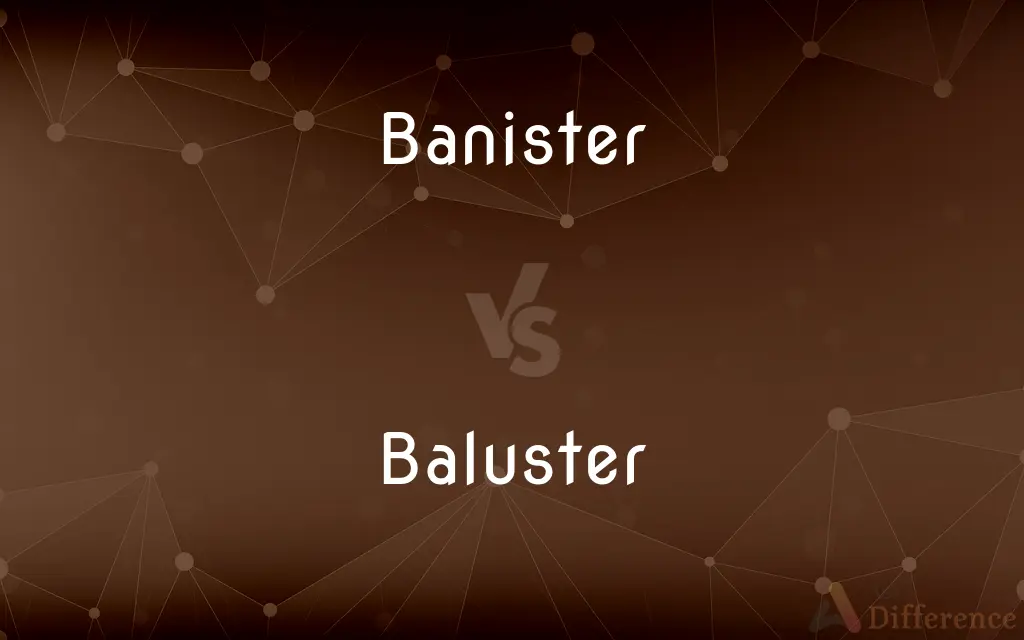Banister vs. Baluster — What's the Difference?
Edited by Tayyaba Rehman — By Fiza Rafique — Updated on April 17, 2024
A banister refers to the handrail along a staircase, whereas a baluster is a vertical support that holds up the banister.

Difference Between Banister and Baluster
Table of Contents
ADVERTISEMENT
Key Differences
A banister is commonly understood as the handrail of a staircase, providing support and stability for those ascending or descending the stairs. On the other hand, balusters are the vertical posts or legs that support the banister, often spaced evenly along the length of the rail.
Banisters are often designed for ergonomic comfort and safety, typically featuring a smooth, continuous surface that is easy to grip. Conversely, balusters can be ornamental and varied in design, ranging from simple columns to intricately carved pieces, contributing to the aesthetic of the staircase.
While the main function of a banister is to offer a handhold and prevent falls, balusters serve primarily as structural components that reinforce the staircase's integrity and prevent objects or people from falling through the gaps.
In terms of materials, banisters can be made from wood, metal, or plastic, depending on the architectural style and functional requirements. Balusters, while also available in various materials, often match or complement the banister to provide a cohesive look.
Banisters may be part of a larger balustrade system but can also exist with minimal or even no balusters in some modern designs. In contrast, balusters are not standalone elements; they are always part of a system that includes a banister or handrail.
ADVERTISEMENT
Comparison Chart
Function
Serves as a handrail for support and safety
Supports the banister and prevents falls through gaps
Design
Typically smooth and continuous for easy grip
Can be highly ornamental, with varied designs
Material
Wood, metal, plastic
Often matches banister, using wood, metal, or stone
Structural Role
Provides a handhold and may serve decorative purposes
Primarily structural, essential for the stability of the rail
Independence
Can exist without balusters in minimalistic designs
Cannot function independently; always paired with a banister
Compare with Definitions
Banister
A support or guide rail in various forms.
The new office building features a glass banister for a modern touch.
Baluster
Decorative as well as functional.
The designer selected custom balusters to complement the home's historic aesthetic.
Banister
A rail serving as a guard at the edge of a balcony or landing.
The child peeked through the banister on the upper floor.
Baluster
One of several vertical supports for a banister.
Each baluster was intricately carved, showcasing exceptional craftsmanship.
Banister
Often used interchangeably with "handrail."
The wooden banister was polished to a high shine.
Baluster
Can be made of various materials like wood, stone, or metal.
The iron balusters were chosen for their durability and style.
Banister
A handrail alongside a staircase.
She held tightly to the banister as she descended the steep stairs.
Baluster
Often part of a balustrade.
The balusters were spaced perfectly to create a rhythmic pattern.
Banister
Part of a stairway's architecture.
The banister was adorned with holiday decorations.
Baluster
A small column or pillar supporting a rail.
The marble balusters added a touch of elegance to the grand staircase.
Banister
The structure formed by the uprights and handrail at the side of a staircase
He vaulted the banister
She peered over the banisters
Baluster
A baluster is a vertical moulded shaft, square, or lathe-turned form found in stairways, parapets, and other architectural features. In furniture construction it is known as a spindle.
Banister
A handrail, especially on a staircase.
Baluster
A short decorative pillar forming part of a series supporting a rail or coping.
Banister
Such a handrail together with its supporting structures.
Baluster
One of the upright, usually rounded or vase-shaped supports of a balustrade.
Banister
One of the vertical supports of a handrail; a baluster.
Baluster
An upright support, such as a furniture leg, having a similar shape.
Banister
The handrail on the side of a staircase.
Baluster
One of the supporting posts of a handrail.
Banister
One of the vertical supports of a handrail; a baluster.
Baluster
(architecture) A short column used in a group to support a rail, as commonly found on the side of a stairway; a banister. 17
Banister
To construct a banister
Baluster
A small column or pilaster, used as a support to the rail of an open parapet, to guard the side of a staircase, or the front of a gallery. See Balustrade.
Banister
To act as a banister
Baluster
One of a number of closely spaced supports for a railing
Banister
A baluster.
Banister
The balustrade of a staircase. Formerly used in this sense mostly in the plural, now mostly in the singular.
He struggled to ascend the pulpit stairs, holding hard on the banisters. Sir W. Scott.
Banister
A railing at the side of a staircase or balcony to prevent people from falling
Common Curiosities
Are banisters and balusters made from the same materials?
Often, but not always; banisters and balusters can be made from the same materials for aesthetic cohesion but can also differ based on design needs.
What is the primary purpose of a banister?
The primary purpose of a banister is to provide safety and support along a staircase.
Can balusters be decorative?
Yes, balusters can be highly decorative, with various designs that enhance the staircase's aesthetic.
What is the difference between a banister and a railing?
"Banister" typically refers to the handrail on a staircase, while "railing" can be any protective barrier, including those on balconies or decks.
Can balusters be replaced individually?
Yes, individual balusters can be replaced if damaged or for a design update.
Is a banister necessary for all staircases?
While most staircases have banisters for safety, some modern designs may omit them or use alternative designs.
How do banisters differ from balustrades?
A banister refers specifically to the handrail, while a balustrade is the entire assembly that includes the banister and balusters.
What is the typical height of a banister?
The typical height of a banister is usually between 34 and 38 inches, according to building codes.
What happens if a staircase doesn't have balusters?
Without balusters, a staircase would lack certain safety elements, potentially allowing objects or small pets to fall through gaps.
Do all balusters have the same shape?
No, balusters come in various shapes and styles, from simple forms to complex sculptural elements.
Are there regulations governing the design of banisters and balusters?
Yes, there are building codes and regulations that specify requirements for banisters and balusters to ensure safety.
How are balusters attached to the staircase?
Balusters are typically attached to the treads of the staircase and the underside of the banister.
How do balusters support the structural integrity of staircases?
Balusters help distribute the load across the staircase and prevent excessive stress on any single part of the banister.
What maintenance do banisters and balusters require?
Maintenance can include regular cleaning, occasional polishing, and periodic checks for stability and wear.
Can a staircase have more than one banister?
Yes, staircases can have banisters on both sides, particularly in wider or public staircases for added safety.
Share Your Discovery

Previous Comparison
Democracy vs. Oligarchy
Next Comparison
Pure vs. PuristAuthor Spotlight
Written by
Fiza RafiqueFiza Rafique is a skilled content writer at AskDifference.com, where she meticulously refines and enhances written pieces. Drawing from her vast editorial expertise, Fiza ensures clarity, accuracy, and precision in every article. Passionate about language, she continually seeks to elevate the quality of content for readers worldwide.
Edited by
Tayyaba RehmanTayyaba Rehman is a distinguished writer, currently serving as a primary contributor to askdifference.com. As a researcher in semantics and etymology, Tayyaba's passion for the complexity of languages and their distinctions has found a perfect home on the platform. Tayyaba delves into the intricacies of language, distinguishing between commonly confused words and phrases, thereby providing clarity for readers worldwide.














































